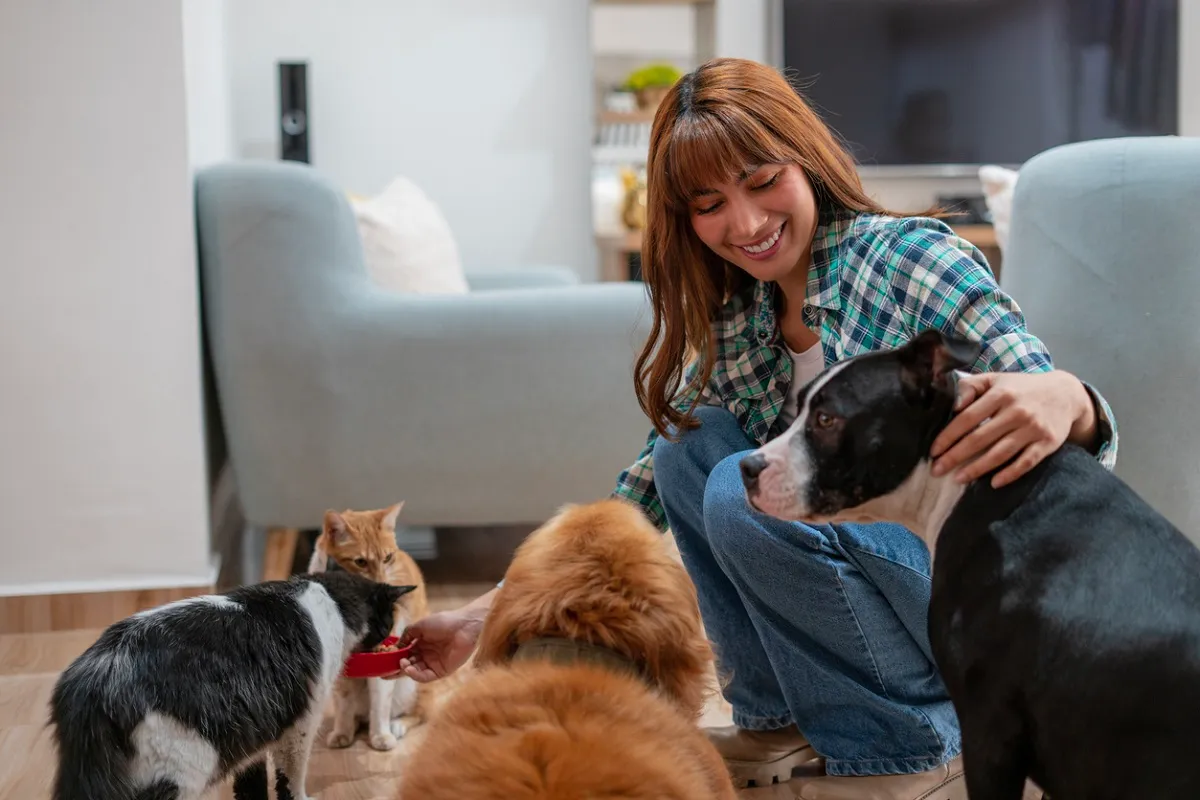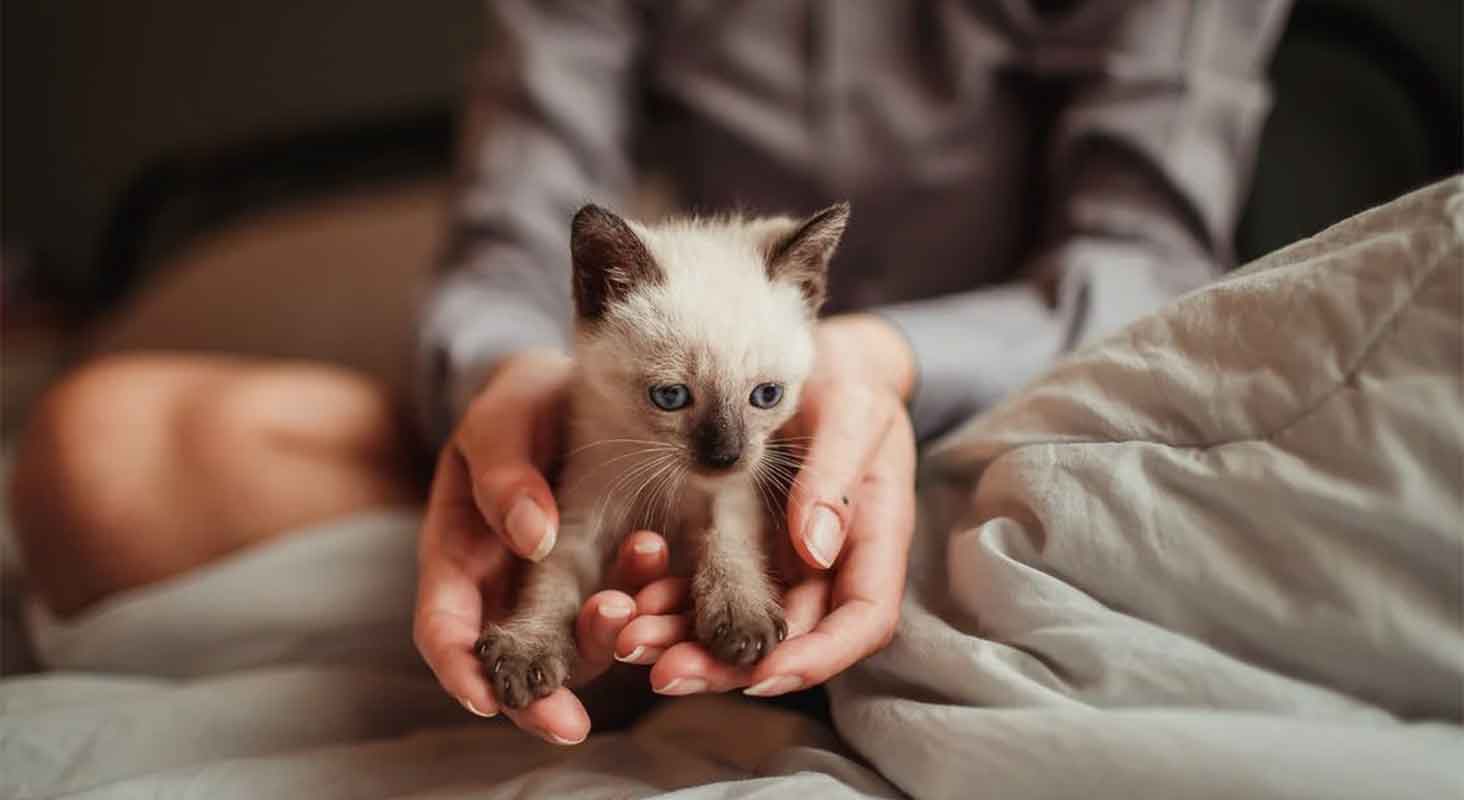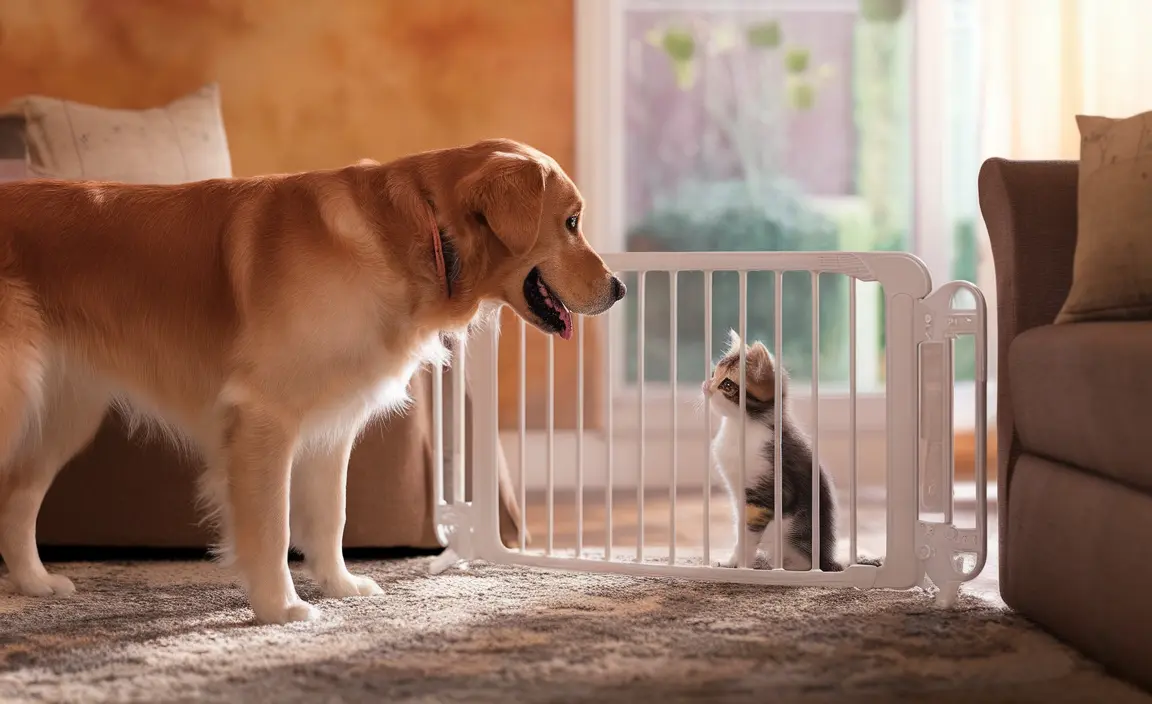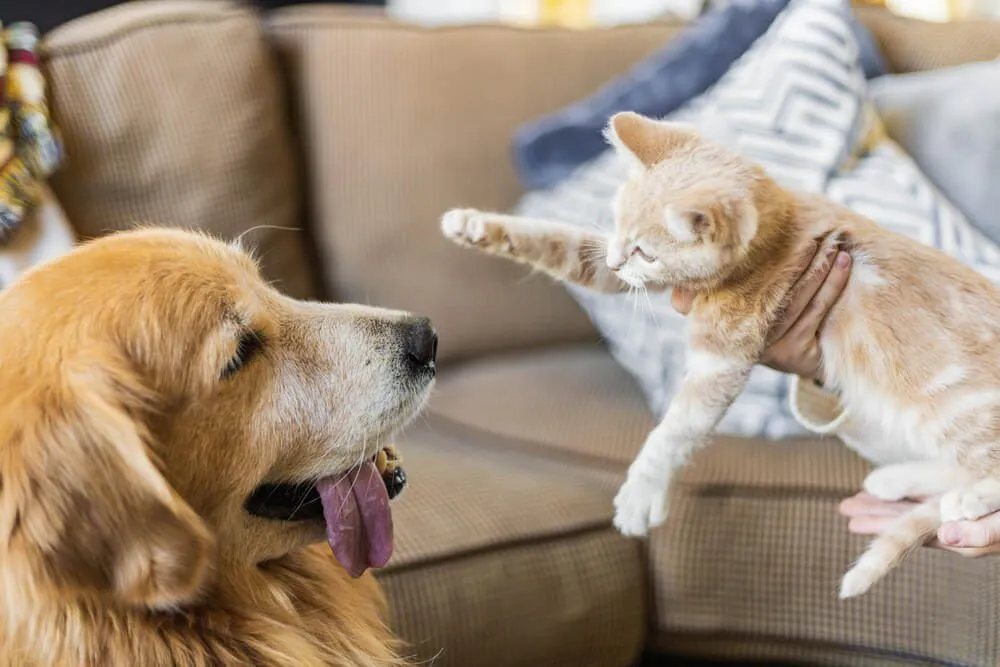Bringing a new kitten into a home with a dog can feel exciting and a little nerve-wracking. I know how much you want both pets to get along and feel safe. The first introduction sets the tone for their future relationship so it’s important to get it right.
I’ve seen how patience and the right approach can make all the difference. With a few simple steps you can help your dog and kitten start off on the right paw. Let’s make this transition as smooth and stress-free as possible for everyone involved.
Understanding Pet Personalities

Understanding-Pet-Personalities
Pet temperaments directly influence first meetings between kittens and dogs. I assess each animal’s comfort with change, history with other pets, and energy levels before any interaction.
- Kitten Personality Types:
Shy kittens (e.g., hiding, slow to approach unfamiliar people or environments) likely need gradual exposure and more space. Bold kittens (e.g., eager, playful with new objects) may initiate contact faster.
- Dog Personality Types:
Calm dogs (e.g., older, low reactivity to sounds) cope best with introductions. High-energy dogs (e.g., puppies, breeds like Border Collies) need extra supervision. Prey-driven dogs (e.g., Terriers, Hounds) require slow, structured steps.
- Human Supervision:
Direct supervision prevents accidental injuries. Positive reinforcement (e.g., treats, praise) encourages acceptance for both pets.
Common behavioral signs signal readiness or stress in kittens and dogs. I monitor body language and vocalizations for context.
Typical Pet Personality Indicators
| Trait | Kitten Example | Dog Example |
|---|---|---|
| Shy | Hiding, avoiding people | Hiding, tucked tail |
| Curious | Sniffing, exploring | Sniffing, gentle approach |
| Bold | Immediate play, pouncing | Jumping, playful stance |
| Fearful | Hissing, flattened ears | Whining, cowering |
| Aggressive | Swatting, growling | Barking, growling |
Personality Compatibility Table
| Dog Personality | Kitten Personality | Introduction Approach |
|---|---|---|
| Calm | Shy | Slow, distant exposure |
| Calm | Bold | Direct but controlled |
| High-Energy | Shy | Gradual, leashed dog |
| High-Energy | Bold | Structured, monitored |
| Prey-driven | Any | Extra caution, barriers |
Matching pets by temperament helps reduce stress. I always customize my approach based on the signs both pets display during initial observations.
Preparing Your Home for a New Kitten

Preparing-Your-Home-for-a-New-Kitten
I start the process by setting up my home to support both my new kitten’s comfort and my dog’s boundaries. A controlled environment and the right supplies lower risks and help both animals adjust.
Creating Safe Spaces
I create a quiet, kitten-proof room free of hazards. I choose a spot away from high-traffic areas and close off spaces where the kitten might get trapped. I include a litter box, food, water, bedding, and toys, making the room both comfortable and secure. I use barriers like baby gates or closed doors, so my dog can sense but not access the kitten. Cat trees and shelves allow the kitten vertical escape routes if the dog approaches.
Safe Space Setup Features
| Feature | Kitten-Specific Example | Purpose |
|---|---|---|
| Litter box | Uncovered, small-sized | Encourages proper litter use |
| Vertical escapes | Cat tree, wall shelves | Offers retreat options |
| Barriers | Baby gate, closed door | Controls direct access |
| No hazards | No wires, strings, or plants | Avoids accidents / poisoning |
Gathering Essential Supplies
I stock up on kitten-exclusive supplies before bringing the kitten home. My checklist covers nutrition, hygiene, comfort, and enrichment needs. I inspect each item for safety and suitability for kittens.
Essential Kitten Supplies
| Item | Specification | Reason for Use |
|---|---|---|
| Food | Kitten-formula by age | Supports growth |
| Litter box | Easy entry, unscented litter | Encourages regular use |
| Scratching post | Stable, sisal-wrapped | Protects furniture |
| Toys | Small, non-toxic, varied texture | Mental & physical exercise |
| Bedding | Soft, washable | Comfort and warmth |
| Hiding spaces | Cardboard box, cat tunnel | Provides security |
I keep the kitten’s area clean by removing dangerous items, cleaning spills, and washing bedding frequently. These steps make the home ready for gradual, low-stress interaction when introducing my dog and kitten for the first time.
Step-By-Step Guide on How to Introduce Kitten to Dog

Step-By-Step-Guide-on-How-to-Introduce-Kitten-to-Dog
Introducing a kitten to a dog in your home follows a structured approach built on patience and observation. I use a proven sequence to gradually develop trust, allowing the kitten and dog to adjust safely.
The First Meeting
The first meeting between a kitten and dog happens in a controlled space. I keep my dog on a leash or in a crate, while the kitten moves freely or seeks height, such as on a cat tree or shelf. I ensure both pets have safe escape routes and no chance of surprise contact. Calm, non-aggressive body language—like the dog sitting quietly or the kitten exploring without hissing—signals readiness to proceed.
Key Behavior Signs for a Successful First Meeting
| Animal | Signs of Calm | Signs of Stress |
|---|---|---|
| Dog | Soft eyes, relaxed posture, tail wag | Stiff body, prolonged staring, lunging |
| Kitten | Exploring, upright tail, quiet | Hissing, hiding, arched back |
Controlled Interactions and Positive Reinforcement
Controlled interactions with positive reinforcement follow a successful first encounter. I supervise every session closely. When either pet behaves calmly—my dog sits quietly or my kitten approaches without fear—I reward with treats or praise. Sessions stay short, increasing only if both animals remain at ease. I immediately stop the session if the dog shows excitement or aggression or if the kitten freezes or flees. Observing and rewarding peaceful behavior builds lasting positive associations.
Structure of Guided Interactions
| Step | Environment | Action |
|---|---|---|
| Initial Meeting | Dog restrained (leash/crate), kitten free | Allow kitten to approach/retreat, monitor closely, reward calm |
| Ongoing Sessions | Gradually increase time and proximity | End session if stress signs appear, continue praise for calm |
Gradual Increase in Supervised Time Together
Gradual increases in supervised time together stabilize the new relationship. Once both the kitten and dog respond with curiosity or calm, I extend each session and allow more freedom, eventually letting the dog off leash under close watch. Every interaction receives supervision for several weeks, as recommended by the American Humane Society and RSPCA. I always prioritize safety by never leaving the kitten and dog unsupervised until I observe consistently relaxed interactions.
Recommended Timeline for Supervised Sessions
| Phase | Duration (approximate) | Supervision Type |
|---|---|---|
| First contact | 5–10 minutes | On-leash/crate only |
| Daily short sessions | 10–15 minutes/session | On-leash, kitten free |
| Consistent calm observed | Increase to 30+ minutes | Off-leash, monitored |
By applying each step in sequence, I reduce stress and create an environment where my dog and kitten can build a positive, lasting bond.
Common Challenges and Solutions
Introducing a kitten to a dog often triggers stress and sometimes aggression. Recognizing and addressing these challenges early sets the stage for a peaceful home.
Managing Signs of Stress
Stress signs in dogs and kittens can easily go unnoticed without close observation. I monitor signals like tense body posture, growling from the dog, or hissing and fleeing attempts from the kitten. These behaviors highlight discomfort that makes further interactions risky.
I reward relaxed body language and calm, neutral curiosity in both pets using small treats and praise, reinforcing positive behavior. I also use interactive toys to help my dog focus away from the kitten, lowering arousal levels during early meetings. Supervised sessions remain brief until both pets consistently display relaxed signals.
| Stress Sign | Dog Example | Kitten Example |
|---|---|---|
| Body posture | Stiff tail, tense stance | Arched back, crouching |
| Vocalization | Growling, whining | Hissing, yowling |
| Escape attempts | Pulling on leash, retreat | Running to hide, high places |
| Avoidant behavior | Turning away, licking lips | Ears flat, swatting |
Addressing Aggressive Behavior
Immediate action becomes necessary if aggression appears from the dog or kitten. I always keep my dog on a leash during initial introductions, which prevents lunging or chasing. Should aggressive behaviors emerge—like barking, snapping, or pouncing—I calmly remove my dog from the area and wait until both animals relax before trying again.
Physical barriers like baby gates separate spaces while allowing visual and scent exposure, reducing territorial impulses and preventing direct contact. Gradual, repeated exposure with increased interaction time happens only when both pets remain calm together.
| Aggressive Behavior | Dog Example | Kitten Example |
|---|---|---|
| Charging or lunging | Barking, straining | Arching, swatting |
| Direct physical threat | Snapping, nipping | Clawing, biting |
| Resource guarding | Blocking access | Hissing at food/toys |
By continuously supervising and rewarding calm moments, I shift both pets’ focus from confrontation to coexistence. Vertical escape routes for kittens and safe physically-separated introductions for dogs prevent escalation, ensuring a positive association during each session.
Tips for Long-Term Harmony
Maintaining harmony between a kitten and a dog centers on ongoing management, patience, and understanding each pet’s comfort levels. I focus on these strategies to reinforce peaceful coexistence and reduce the risk of stress or conflict over time.
- Respect escape needs: I always provide the kitten with vertical spaces or safe rooms to retreat when needed. Cat trees, shelves, and gated rooms offer examples of safe escapes.
- Reward calm behavior: I consistently use treats, toys, or praise to reinforce calm, friendly interactions between my dog and kitten. Positive reinforcement increases the likelihood of repeated good behavior.
- Supervise early interactions: I keep all unsupervised meetings off-limits, especially in the first weeks. If my dog or kitten shows persistent anxiety or stress, I return to controlled, shorter sessions.
- Maintain distinct pet zones: I assign separate eating, resting, and litter areas to help avoid food aggression or territorial disputes. Bowls, litter boxes, and beds for each pet minimize resource guarding.
- Monitor body language: I look for subtle clues—loose body, tail position, ear orientation—to catch any sudden tension. Quick intervention can prevent escalation into aggressive behaviors.
- Continue training sessions: I practice obedience commands with my dog, such as “leave it” and “stay,” to reinforce impulse control for every interaction.
- Be patient with adjustment: I watch for progress at each pet’s pace. Some dogs or kittens may show reliable tolerance in days, while others need several weeks.
Table: Key Practices for Ongoing Harmony
| Practice | Example Actions | Benefit |
|---|---|---|
| Safe Retreats | Provide cat trees, private rooms | Reduces kitten stress |
| Consistent Rewards | Use treats for calm behavior | Reinforces positive actions |
| Supervised Interactions | Limit unsupervised sessions, increase gradually | Limits risk of aggression |
| Separate Pet Zones | Separate eating/litter stations | Minimizes territorial conflict |
| Active Training | Practice “leave it,” “sit,” and impulse control | Improves dog’s response |
Table: Signs of Long-Term Compatibility
| Sign in Kitten | Sign in Dog | Meaning |
|---|---|---|
| Relaxed body, normal grooming | Loose tail wag, soft posture | High compatibility, low stress |
| Occasional retreat, calm return | Looks away, yawns | Building trust, self-soothing |
| Playful approach, curiosity | Gentle sniff, ignores kitten | Positive social interest |
These sustained actions support mutual trust and allow both pets to thrive in a shared home. If either pet shows regression or new stress signs, I reassess the setup and return to gradual exposure, ensuring continuous progress toward harmony.
Conclusion
Bringing a kitten into a home with a dog is a journey that requires patience and a flexible mindset. Every pet has its own personality and pace, so I always remind myself to stay observant and adjust as needed.
The process is as much about building trust as it is about managing introductions. With a calm approach and ongoing support, I’ve found that both pets can learn to coexist and even become friends.
By staying attentive to their needs and celebrating small wins along the way, I can create a peaceful and happy environment for everyone.
Frequently Asked Questions
How do I safely introduce a new kitten to my dog?
Start by setting up a kitten-proof room with all essentials and keep your dog separated initially. Allow your pets to sniff each other under a door or through a barrier. Gradually introduce them in a controlled, supervised environment, rewarding calm behavior and closely observing their body language.
What signs indicate my kitten or dog is stressed during introductions?
Signs of stress include tense body posture, growling or hissing, hiding, raised fur, flattened ears, and excessive vocalizations. If you notice any of these, separate your pets and try introductions again more slowly.
How long does it usually take for a dog and kitten to get along?
It depends on their individual personalities and prior experiences. Some pets adjust within a few days, while others may need several weeks. Patience, gradual introductions, and positive reinforcement are key for a successful relationship.
What supplies do I need to prepare for my new kitten?
You’ll need a litter box, kitten food and bowls, a cozy bed, scratching posts, safe toys, and a separate, quiet space for the kitten. Make sure the area is kitten-proof to prevent accidents or escapes.
Is it better to match pet personalities when introducing a kitten to a dog?
Yes, matching personalities—like pairing a calm dog with a shy kitten—can make the transition smoother. Understanding each pet’s temperament helps tailor your approach and reduces stress during introductions.
Should I always supervise interactions between my kitten and dog?
Yes, supervision is essential during the early stages of introduction to prevent accidents and ensure positive interactions. Increase unsupervised time only when both pets consistently show calm, relaxed behavior around each other.
What should I do if my dog acts aggressively toward the new kitten?
Immediately separate them and try reintroducing more gradually. Keep your dog leashed during initial meetings and use barriers if needed. Reward calm behavior and consult a professional if aggression continues.
How can I encourage my dog and kitten to accept each other?
Use positive reinforcement like treats and praise for calm interactions. Provide both pets with their own spaces and allow them to approach each other at their own pace. Avoid forcing direct contact.
When can I let my kitten and dog interact freely?
Allow free interaction only when both pets are consistently relaxed and calm in each other’s presence, with no signs of stress or aggression. Continue to monitor their behavior for any changes.
What steps can I take to ensure long-term harmony between my dog and kitten?
Maintain distinct pet zones, keep up with training, provide the kitten with safe retreats, and watch their body language. Continue rewarding calm behavior and adjust your approach if either pet shows discomfort.

